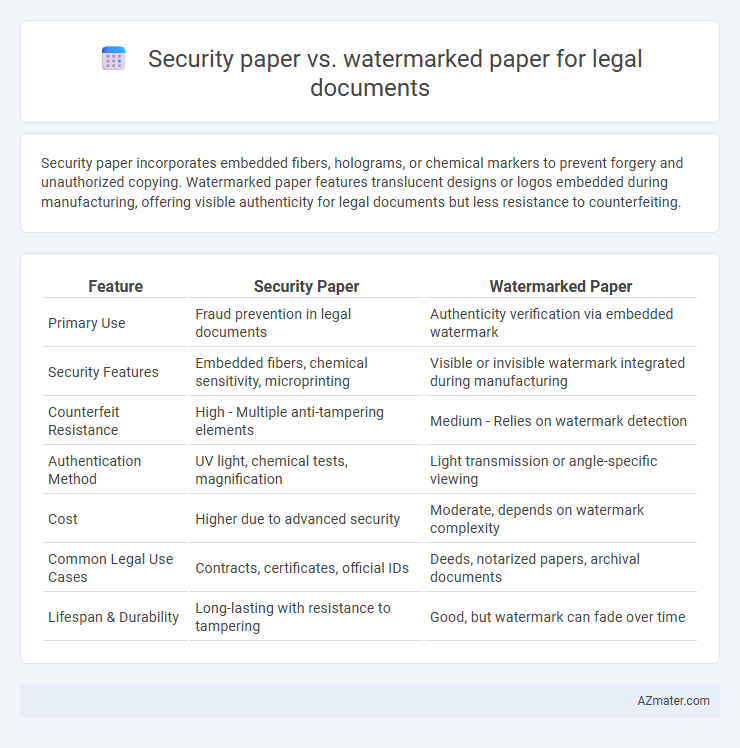Security paper incorporates embedded fibers, holograms, or chemical markers to prevent forgery and unauthorized copying. Watermarked paper features translucent designs or logos embedded during manufacturing, offering visible authenticity for legal documents but less resistance to counterfeiting.
Table of Comparison
| Feature | Security Paper | Watermarked Paper |
|---|---|---|
| Primary Use | Fraud prevention in legal documents | Authenticity verification via embedded watermark |
| Security Features | Embedded fibers, chemical sensitivity, microprinting | Visible or invisible watermark integrated during manufacturing |
| Counterfeit Resistance | High - Multiple anti-tampering elements | Medium - Relies on watermark detection |
| Authentication Method | UV light, chemical tests, magnification | Light transmission or angle-specific viewing |
| Cost | Higher due to advanced security | Moderate, depends on watermark complexity |
| Common Legal Use Cases | Contracts, certificates, official IDs | Deeds, notarized papers, archival documents |
| Lifespan & Durability | Long-lasting with resistance to tampering | Good, but watermark can fade over time |
Introduction to Legal Document Paper Types
Security paper and watermarked paper serve as essential types of legal document papers designed to prevent forgery and unauthorized duplication. Security paper incorporates embedded features such as microprinting, UV fibers, and chemical-sensitive elements that enhance document authenticity and deter tampering. Watermarked paper displays translucent designs or text visible when held against light, providing a straightforward yet effective visual authentication method widely used in legal contracts and certificates.
Understanding Security Paper: Key Features
Security paper incorporates embedded fibers, chemical sensitivity, and microprinting to prevent counterfeiting and unauthorized alterations in legal documents. Watermarked paper features a translucent design visible when held against light, enhancing authenticity but offering limited protection compared to security paper's multifaceted safeguards. These key features make security paper the preferred choice for high-stakes legal documents requiring rigorous verification and tamper-evidence.
What Is Watermarked Paper?
Watermarked paper is a type of security paper embedded with a faint, translucent design or pattern visible when held against light, used to authenticate and protect legal documents from counterfeiting. Unlike regular security paper that may include features like microprinting or anti-copy patterns, watermarked paper relies on its distinct watermark as a key element of document integrity and verification. This specialized paper is widely preferred for legal contracts, certificates, and official records due to its enhanced ability to deter fraud and ensure document originality.
Security Paper vs Watermarked Paper: Core Differences
Security paper incorporates integrated features like embedded fibers, security threads, and chemical sensitizers to prevent counterfeiting and tampering, while watermarked paper primarily uses translucent designs created during manufacturing to verify authenticity. Security paper offers a higher level of protection against forgery with complex anti-copy elements, whereas watermarked paper provides a simpler visual authenticity check that is easily recognizable under light. Legal documents relying on security paper benefit from multi-layered safeguards, whereas watermarked paper serves as a basic but essential deterrent in document validation.
Importance of Paper Security in Legal Documents
Security paper features embedded anti-counterfeit measures like fibers, holograms, or microtext, crucial for preventing forgery in legal documents. Watermarked paper offers an additional layer of authenticity verification by displaying unique translucent patterns visible under light, deterring unauthorized duplication. Employing these specialized papers safeguards the integrity and trustworthiness of contracts, certificates, and official records by ensuring their authenticity and protection against tampering.
Anti-Counterfeiting Measures in Security Paper
Security paper incorporates advanced anti-counterfeiting measures such as embedded fibers, microprinting, and holograms that are difficult to replicate, providing enhanced protection for legal documents. Watermarked paper relies on translucent designs created during the manufacturing process, serving as a basic deterrent but is more susceptible to forgery compared to security paper. Legal documents benefit from security paper due to its superior ability to verify authenticity and prevent counterfeiting through multiple layered security features.
Role of Watermarks in Document Authentication
Watermarked paper plays a crucial role in document authentication by embedding a unique, often invisible pattern during the paper manufacturing process, which is difficult to replicate or alter. Unlike standard security paper that may rely on multiple security features, watermarks offer a subtle yet highly effective means to verify the document's originality and prevent forgery. This inherent characteristic of watermarked paper enhances trust and integrity in legal documents by providing a reliable visual or machine-readable authentication method.
Cost Comparison: Security Paper and Watermarked Paper
Security paper typically costs more due to embedded features like fibers, threads, or holograms that enhance document authenticity. Watermarked paper, while less expensive, offers moderate protection by embedding a translucent design visible when held against light. Choosing between the two depends on budget constraints and the required level of anti-counterfeiting measures for legal documents.
Choosing the Right Paper for Legal Protection
Security paper features built-in anti-counterfeit elements such as embedded fibers, microprinting, or UV-reactive threads that help verify authenticity and prevent tampering in legal documents. Watermarked paper carries a translucent design embedded during manufacturing, offering a visible security mark that deters forgery and enhances document credibility. Selecting the right paper depends on the required level of protection, with security paper providing advanced forensic safeguards and watermarked paper being suitable for standard verification needs in legal documentation.
Future Trends in Legal Document Security
Security paper continues to evolve with embedded microfibers, chemical sensitizers, and advanced holographic elements to combat counterfeiting in legal documents. Watermarked paper integrates dynamic, multi-tone watermarks with digital cryptographic features, enhancing authenticity verification through blockchain-linked identifiers. Emerging trends indicate a convergence of physical security features and digital authentication methods to create robust, tamper-evident legal documents for future-proof security.

Infographic: Security paper vs Watermarked paper for Legal document
 azmater.com
azmater.com